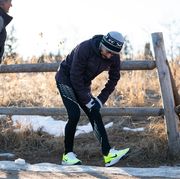Training follows a principle known as progressive overload, which simply means we need to keep stressing the body in gradual (and good) increments for improved performance. Easing into harder training over time stimulates a cascade of physiological responses that make the body stronger. Muscles, tendons, bones and ligaments toughen up, your heart and lungs become stronger and more efficient, and numerous other adaptations are impacting other systems within your body.
On the flip side, if, or when, you tax the body too much and it is not able to adapt adequately to the demand placed upon it, you are then susceptible to injury, illness, fatigue, or burnout. This scenario is what your running friends want you to avoid.
Having a basic foundation requires a minimum of consistent training for at least 10 to 12 weeks. (This time frame can vary widely depending upon one’s fitness level at the outset.) A sedentary lifestyle, certain health conditions, obesity, or previous injuries may mean a slower progression is required.
I suggest you continue your training for another four weeks, but during these next four weeks you can up the intensity slightly by doing some basic speed conditioning work. These simple workouts will help prepare your body for the demands of the track by being shorter in length and no more than three miles. (You should also include a warmup and cooldown.)
Related video: Here is how you can warm up in just five minutes.
One run to get you pumping your legs a little faster would be a fartlek run on the road. For this workout, run slightly faster for one to two minutes, then back off and recover for three to four minutes. Repeat this sequence for the duration of your run.
Another way to build strength for the flat track is to add a hilly run into your normal routine. Also, continue increasing your run distance to six miles. Once you get there comfortably, the track won’t feel daunting at all.
Whenever I get this question from new runners, I have them ask themselves these questions before moving to the track:
- Does your running feel easy?
- Is your distance up to 5 or 6 miles for your long run?
- Do you experience any aches or pains before, during, or after running?
- Is your breathing comfortable or labored?
- Do you have a base built of at least 10 to 12 weeks?
- Have you done any speed conditioning workouts (max of three mils to start)?
- Are you doing warmups and cooldowns before harder workouts?
If you can check off all these questions, then you are less likely to tax your body too much when you go to the track—or do any type of speed workout.
Join Runner's World+ for unlimited access to the best training tips for runners
Susan Paul has coached more than 2,000 runners and is an exercise physiologist and program director for the Orlando Track Shack Foundation. For more information, visit www.trackshack.com.













